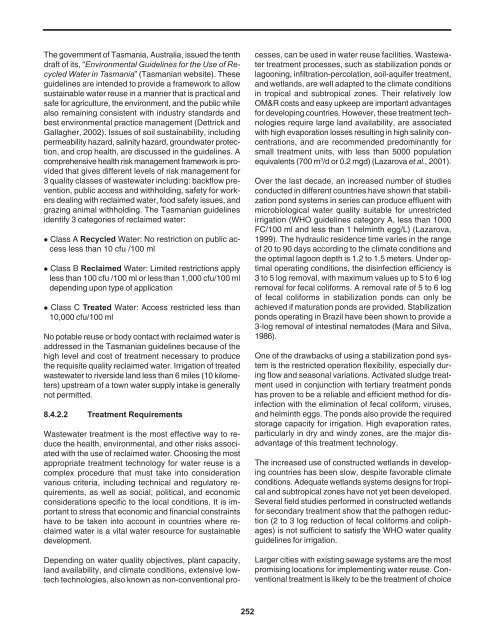o_19f3m1n7k170b14e9u0oqipgu4a.pdf
You also want an ePaper? Increase the reach of your titles
YUMPU automatically turns print PDFs into web optimized ePapers that Google loves.
The government of Tasmania, Australia, issued the tenth<br />
draft of its, “Environmental Guidelines for the Use of Recycled<br />
Water in Tasmania” (Tasmanian website). These<br />
guidelines are intended to provide a framework to allow<br />
sustainable water reuse in a manner that is practical and<br />
safe for agriculture, the environment, and the public while<br />
also remaining consistent with industry standards and<br />
best environmental practice management (Dettrick and<br />
Gallagher, 2002). Issues of soil sustainability, including<br />
permeability hazard, salinity hazard, groundwater protection,<br />
and crop health, are discussed in the guidelines. A<br />
comprehensive health risk management framework is provided<br />
that gives different levels of risk management for<br />
3 quality classes of wastewater including: backflow prevention,<br />
public access and withholding, safety for workers<br />
dealing with reclaimed water, food safety issues, and<br />
grazing animal withholding. The Tasmanian guidelines<br />
identify 3 categories of reclaimed water:<br />
• Class A Recycled Water: No restriction on public access<br />
less than 10 cfu /100 ml<br />
• Class B Reclaimed Water: Limited restrictions apply<br />
less than 100 cfu /100 ml or less than 1,000 cfu/100 ml<br />
depending upon type of application<br />
• Class C Treated Water: Access restricted less than<br />
10,000 cfu/100 ml<br />
No potable reuse or body contact with reclaimed water is<br />
addressed in the Tasmanian guidelines because of the<br />
high level and cost of treatment necessary to produce<br />
the requisite quality reclaimed water. Irrigation of treated<br />
wastewater to riverside land less than 6 miles (10 kilometers)<br />
upstream of a town water supply intake is generally<br />
not permitted.<br />
8.4.2.2 Treatment Requirements<br />
Wastewater treatment is the most effective way to reduce<br />
the health, environmental, and other risks associated<br />
with the use of reclaimed water. Choosing the most<br />
appropriate treatment technology for water reuse is a<br />
complex procedure that must take into consideration<br />
various criteria, including technical and regulatory requirements,<br />
as well as social, political, and economic<br />
considerations specific to the local conditions. It is important<br />
to stress that economic and financial constraints<br />
have to be taken into account in countries where reclaimed<br />
water is a vital water resource for sustainable<br />
development.<br />
Depending on water quality objectives, plant capacity,<br />
land availability, and climate conditions, extensive lowtech<br />
technologies, also known as non-conventional processes,<br />
can be used in water reuse facilities. Wastewater<br />
treatment processes, such as stabilization ponds or<br />
lagooning, infiltration-percolation, soil-aquifer treatment,<br />
and wetlands, are well adapted to the climate conditions<br />
in tropical and subtropical zones. Their relatively low<br />
OM&R costs and easy upkeep are important advantages<br />
for developing countries. However, these treatment technologies<br />
require large land availability, are associated<br />
with high evaporation losses resulting in high salinity concentrations,<br />
and are recommended predominantly for<br />
small treatment units, with less than 5000 population<br />
equivalents (700 m 3 /d or 0.2 mgd) (Lazarova et al., 2001).<br />
Over the last decade, an increased number of studies<br />
conducted in different countries have shown that stabilization<br />
pond systems in series can produce effluent with<br />
microbiological water quality suitable for unrestricted<br />
irrigation (WHO guidelines category A, less than 1000<br />
FC/100 ml and less than 1 helminth egg/L) (Lazarova,<br />
1999). The hydraulic residence time varies in the range<br />
of 20 to 90 days according to the climate conditions and<br />
the optimal lagoon depth is 1.2 to 1.5 meters. Under optimal<br />
operating conditions, the disinfection efficiency is<br />
3 to 5 log removal, with maximum values up to 5 to 6 log<br />
removal for fecal coliforms. A removal rate of 5 to 6 log<br />
of fecal coliforms in stabilization ponds can only be<br />
achieved if maturation ponds are provided. Stabilization<br />
ponds operating in Brazil have been shown to provide a<br />
3-log removal of intestinal nematodes (Mara and Silva,<br />
1986).<br />
One of the drawbacks of using a stabilization pond system<br />
is the restricted operation flexibility, especially during<br />
flow and seasonal variations. Activated sludge treatment<br />
used in conjunction with tertiary treatment ponds<br />
has proven to be a reliable and efficient method for disinfection<br />
with the elimination of fecal coliform, viruses,<br />
and helminth eggs. The ponds also provide the required<br />
storage capacity for irrigation. High evaporation rates,<br />
particularly in dry and windy zones, are the major disadvantage<br />
of this treatment technology.<br />
The increased use of constructed wetlands in developing<br />
countries has been slow, despite favorable climate<br />
conditions. Adequate wetlands systems designs for tropical<br />
and subtropical zones have not yet been developed.<br />
Several field studies performed in constructed wetlands<br />
for secondary treatment show that the pathogen reduction<br />
(2 to 3 log reduction of fecal coliforms and coliphages)<br />
is not sufficient to satisfy the WHO water quality<br />
guidelines for irrigation.<br />
Larger cities with existing sewage systems are the most<br />
promising locations for implementing water reuse. Conventional<br />
treatment is likely to be the treatment of choice<br />
252



